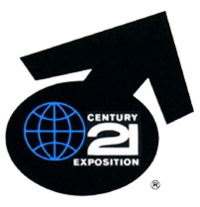Seattle World's Fair
| EXPO Seattle 1962 | |
|---|---|

Century 21 Exposition logo
|
|
| Overview | |
| BIE-class | Universal exposition |
| Category | Second category General Exposition |
| Name | Century 21 Exposition |
| Motto | Living in the Space Age |
| Building | Space Needle |
| Area | 74 acres (30 ha) |
| Invention(s) | Bubbleator, Friendship 7 |
| Visitors | 6,609,609 |
| Organized by | Edward E. Carlson |
| Participant(s) | |
| Countries | 24 |
| Location | |
| Country | United States |
| City | Seattle |
| Venue | Broad Street |
| Coordinates | 47°37′17″N 122°21′03″W / 47.62139°N 122.35083°W |
| Timeline | |
| Bidding | 1955 |
| Opening | April 21, 1962 |
| Closure | October 21, 1962 |
| Universal expositions | |
| Previous | Expo 58 in Brussels |
| Next | Expo 67 in Montreal |
The Century 21 Exposition (also known as the Seattle World's Fair) was a world's fair held April 21, 1962, to October 21, 1962, in Seattle, Washington. Nearly 10 million people attended the fair. Unlike some other world's fairs of its era, Century 21 made a profit.
As planned, the exposition left behind a fairground and numerous public buildings and public works; some credit it with revitalizing Seattle's economic and cultural life (see History of Seattle since 1940). The fair saw the construction of the Space Needle and Alweg monorail, as well as several sports venues (Washington State Coliseum, now KeyArena) and performing arts buildings (the Playhouse, now the Cornish Playhouse), most of which have since been replaced or heavily remodeled.
The site, slightly expanded since the fair, is now called Seattle Center; the United States Science Pavilion is now the Pacific Science Center. Another notable Seattle Center building, the Museum of Pop Culture (earlier called EMP Museum), was built nearly 40 years later and designed to fit in with the fairground atmosphere.
The fair was originally conceived in 1955 to mark the 50th anniversary of the 1909 Alaska–Yukon–Pacific Exposition, but it soon became clear that that date was too ambitious. With the Space Race underway and Boeing having "put Seattle on the map" as "an aerospace city", a major theme of the fair was to show that "the United States was not really 'behind' the Soviet Union in the realms of science and space". As a result, the themes of space, science, and the future completely trumped the earlier conception of a "Festival of the [American] West".
In June 1960, the Bureau International des Expositions (BIE) certified Century 21 as a world's fair. Project manager Ewen Dingwall went to Moscow to request Soviet participation, but was turned down. Neither the People's Republic of China, Vietnam nor North Korea were invited.
...
Wikipedia
